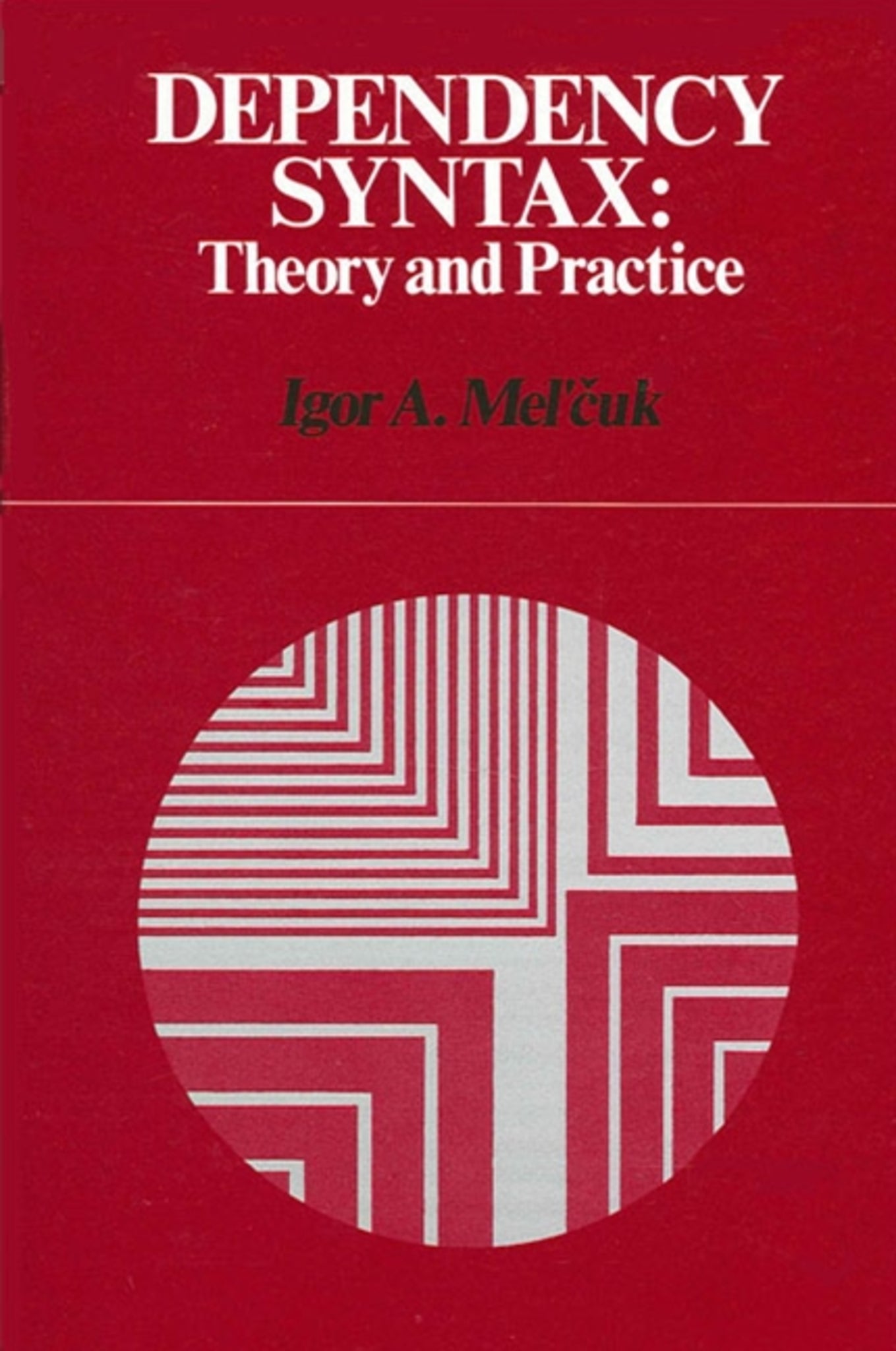We're sorry. An error has occurred
Please cancel or retry.
Dependency Syntax

Some error occured while loading the Quick View. Please close the Quick View and try reloading the page.
Couldn't load pickup availability
- Format:
-
30 September 1987

This work presents the first sustained examination of Dependency Syntax. In clear and stimulating analyses Mel'cuk promotes syntactic description in terms of dependency rather than in terms of more familiar phrase-structure. The notions of dependency relations and dependency structure are introduced and substantiated, and the advantages of dependency representation are demonstrated by applying it to a number of popular linguistic problems, e.g. grammatical subject and ergative construction. A wide array of linguistic data is used - the well-known (Dyirbal), the less known (Lezgian), and the more recent (Alutor). Several "exotic" cases of Russian are discussed to show how dependency can be used to solve difficult technical problems.
The book is not only formal and rigorous, but also strongly theory-oriented and data-based. Special attention is paid to linguistic terminology, specifically to its logical consistency. The dependency formalism is presented within the framework of a new semantics-oriented general linguistic theory, Meaning-Text theory.


Foreword
Mark Aronoff
Acknowledgments
List of Commonly Used Abbreviations and Symbols
I. Dependency Syntax: An Overview
Introduction
I. The Case "Dependency vs. Phrase Structure"1. Basic Elements of Dependency Representation in Syntax
II. Organization of the Presentation
I. Introductory Remarks2. The Meaning-Text Linguistic Model as the Framework for Dependency Syntax
II. Dependency Language vs. Phrase-Structure Language
III. The Rationale behind Syntactic Dependencies
IV. Current Fallacies Concerning Syntactic Dependencies
V. Some Insufficiencies of Syntactic Dependencies
VI. Some Advantages of Syntactic Dependencies
Notes
I. Basic Postulates and Main Properties of a Meaning-Text Model
II. Utterance Representation at Different Levels
III. Major Components of a Meaning-Text Model
Appendix: Two Sample Entries of the Explanatory Combinatorial Dictionaries of French and Russian
I. Sample entries
II. Translating Means of an ECD
Notes
II. An Important Concept of Dependency Syntax: Surface-Syntactic Relations
3. Types of Syntagmatic Dependencies Between Wordforms of a Sentence and Surface Syntactic Relations
I. Possible Types of Syntagmatic Dependencies between Wordforms of a Sentence
1. Morphological DependenciesII. Possible Combinations of Syntagmatic Dependency Types between two Wordforms of a Sentence
2. Syntactic Dependencies
3. Semantic Dependencies
III. Syntactic Dependency: A Logical Analysis of an Important Concept
Notes
III. Syntactic Theory: The Ergative Construction
4. Is There an Ergative Construction in Dyirbal?
I. Introductory Remarks5. Is There an Ergative Construction in Lezgian?
II. A Few Facts About Dyirbal III. Grammatical Subject in Dyirbal
1. Toward the Concept of Grammatical SubjectIV. "Transitive" Verbs in Dyirbal
2. Subjecthood Properties in Dyirbal
V. "Accusative" in Dyirbal
VI. No Ergative Construction in Dyirbal
VII. Active, Passive and Other Voices and "Near-Voices" in Dyirbal
VIII. Analysis of Possible Counterarguments
Notes
I. Introductory Remarks6. Toward a Definition of the Concept "Ergative Construction"
II. A Few Facts About Lezgian
III. Grammatical Subject in Lezgian
1. Subjecthood Properties in LezgianVI. No Ergative Construction in Lezgian
2. Absence of Voice in Lezgian
3. Rejecting Possible Counterarguments
Notes
I. Introductory Remarks
II, The Term Ergative
III. Levels of Representation in the Study of te Ergative Construction
IV. Typology of Predicative Constructions
V. The Ergative Construction: Attempt at a Definition
VI. Origins of the Ergative Construction
Note
IV. Syntactic Descriptions: Surface-Syntactic Models and Notions
7. Toward a Formal Model of Alutor Surface Syntax: Predicative and Completive Constructions
I. A Few Facts about Alutor8. Syntactic, or Lexical, Zero
II. Formalism and Notations Used
III. Nine Surface-Syntax Rules of Alutor
1. Predictive Constructions (Rules 1-3) 2. Completive Constructions with a Finite Transitive Verb in the Non-Resultive (Rules 4-9)IV. Discussion of Predicative and Completive Constructions in Alutor1. The Ergative Construction in AlutorNotes
2. The Special Cases of Object Agreement of the Main Verb
I. The Problem Stated: Questions 1-3 II. From Morphological to Syntactic Zeroes
III. Syntactic, or Lexical, Zeroes in Russian
IV. "Zero" Terminology in Linguistics
V. Answers to Questions 1-3
Notes
V. Syntactic Methodology: Some Thorny Questions of Russian Syntax
9. On a Class of Russian Verbs that Can Introduce Direct Speech: Lexical Polysemy or Semantic Syntax? (Constructions of the type "Ostav'te Menja!" —Ispugalsja Bufetčik)
I. The Russian Direct Speech Sentences with Verbs of Emotion10. Animacy in Russian Cardinal Numerals and Adjectives as an Inflectional Category: A Problem of Agreement
II. The Problem Stated
III. Alternative Solutions: Lexical vs. Syntactic
IV. Three Arguments against the Lexical Solution
V. A Residual Case: Verbs of Emotion Having a Speech Semantic Component
Notes
I. Introductory Remarks11. The Grammatical Case of the Numerical Expressions in Russian: Phrases of the Type (Bol'še) Na Dva Mal'čika or Po Troe Bol'Nyx: A Problem of Government
II. The Problem Stated
III. Alternative Solutions: Animacy vs. a Specific Case
IV. Seven Arguments to Support the Animacy Solution
V. Important Residual Cases
1. In What Inflectional Forms of Adj and Num in Animacy Relevant?Notes
2. For What Lexemes of Adj and Num in Animacy Relevant?
I. Constructions with "Difficult" Case FormsFour Methodological Principles of Linguistic Research
II. The Problem Stated
III. Alternative Solutions: Nominative vs. Inanimate Accusative
IV. Four Arguments in Favor of the Accusative Solution
V. EXCURSUS: The Nominative Noun as a Syntactically Dependent Element in Russian
Notes
References
Indexes
Index of Names
Index of Languages
Index of Subject and Terms



